Food & Wine …
Nutritious Seafood Recipes
Living Heart Healthy
by
Janet P. Caldwell
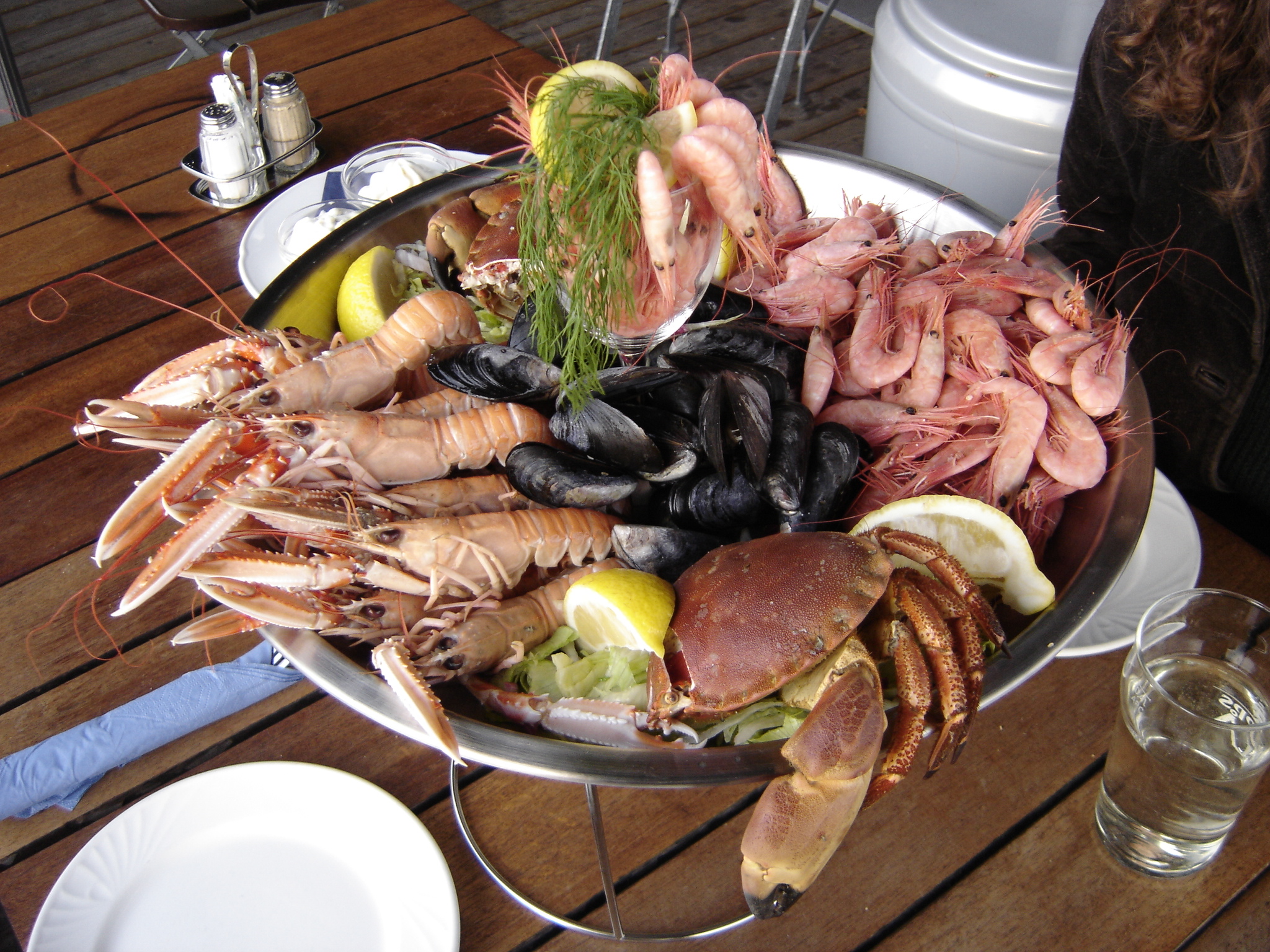
The American Heart Association recommends eating salmon or other fatty fish such as mackerel or tuna twice each week for the heart-protective benefits associated with omega-3 fatty acids found in their fish oils. Our collection of seafood recipes offers a variety of preparation and cooking options to optimize your fish and shellfish based meals.
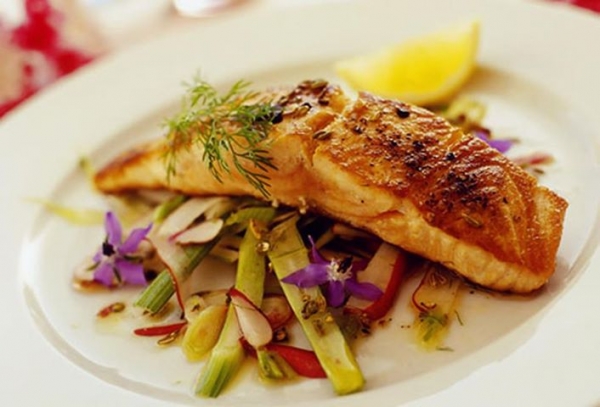
First up is our Seared Scallops with Warm Fruit Salsa. A hot skillet is key to a deep golden sear on the scallops. Prepare the fruit salsa in the same skillet as the scallops for an easy one-pan cleanup. Jasmine rice rounds out the meal.
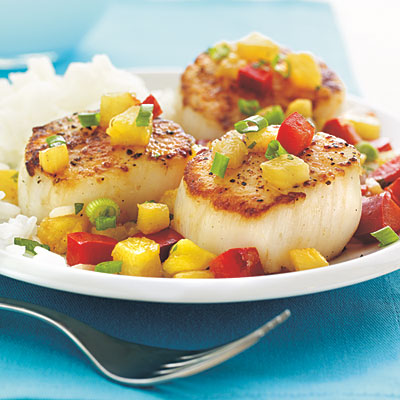
Ingredients
12 large sea scallops (about 1 1/4 pounds)
Cooking Spray
1/4 teaspoon freshly ground black pepper
1/8 teaspoon salt
Warm Fruit Salsa
4 teaspoons sliced green onions
continued . . . .
Note :
MyRecipes is working with Let's Move!, the Partnership for a Healthier America, and USDA's MyPlate to give anyone looking for healthier options access to a trove of recipes that will help them create healthy, tasty plates.
For more information about creating a healthy plate, visit www.choosemyplate.gov.
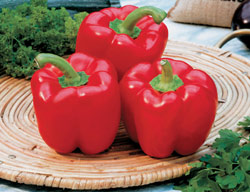
continued . . .
Preparation
Pat scallops dry with paper towels. Heat a large nonstick skillet over medium-high heat. Coat pan with cooking spray. Sprinkle scallops evenly with pepper and salt. Add scallops to pan; cook 3 minutes on each side or until done. Remove scallops from pan; keep warm.
Prepare Warm Fruit Salsa.
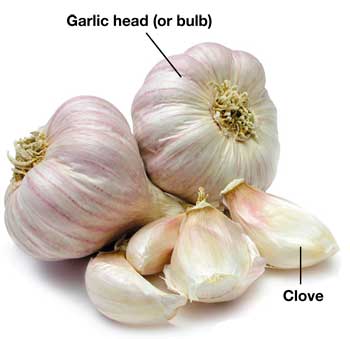
Preparation
& Ingredients
2 teaspoons olive oil
1 garlic clove, minced
2 cups diced pineapple
1 1/4 cups chopped red bell pepper
1/4 cup green tea with mango
2 teaspoons low-sodium soy sauce
1 tablespoon chopped fresh mint
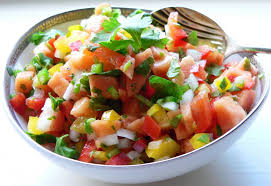
Discard any accumulated juices from scallops; top evenly with Warm Fruit Salsa and onions. Serve immediately.

Fennel the Medicinal Food
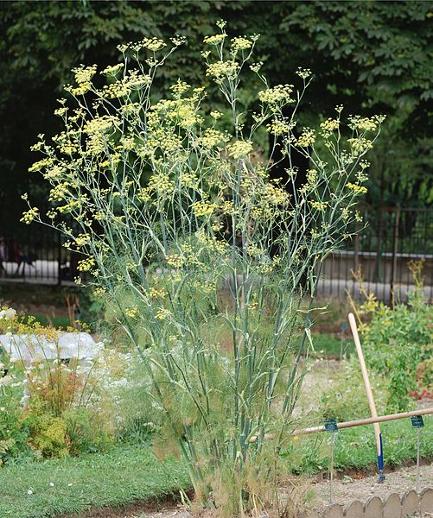
This Spring / Summer season, I am choosing to add fennel to my diet and am sharing a recipe from Whole Living and a bit of history from wikipedia. Fennel offers a crunch, like celery. Fennel is a vegetable and all three parts, the bulb, stalks, and fronds are edible. Fennel is composed of a white or pale green bulb from which closely superimposed stalks are arranged. The stalks are topped with feathery green leaves near which flowers grow and produce fennel seeds. Fennel belongs to the Umbellifereae family and is therefore closely related to parsley, carrots, dill and coriander. Fennel has a distinctive flavor, tasting strongly of anise or licorice when raw. It is a healthy addition to your diet, containing substantial amounts of vitamin C and fiber and very low in calories. Add sliced, raw fennel bulb to green salads.
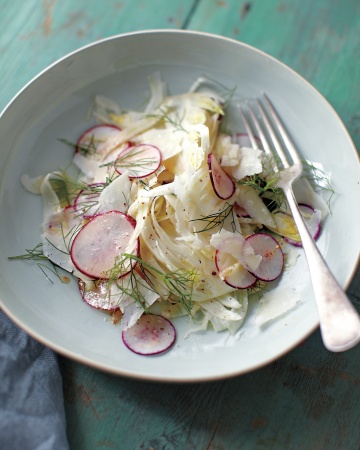
Shaved Radish, Fennel, and Parmesan Salad
Enjoy this crisp, refreshing slaw on its own or pair it with a hearty main course. The mellow flavor of the raw fennel balances beautifully with the radishes' spicy bite. Nutty Parmesan brings it all together.
Ingredients
2 tablespoons extra-virgin olive oil
1 tablespoon fresh lemon juice
2 teaspoons whole-grain mustard
Coarse salt and ground black pepper
1 bulb fennel, cored and thinly sliced, plus 1/4 cup fronds
5 radishes, thinly sliced
3 tablespoons freshly shaved Parmesan
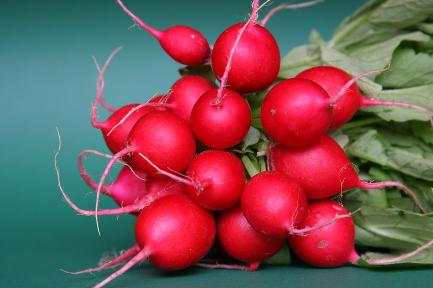
Directions
Whisk together oil, lemon juice, and mustard and season with salt and pepper. Toss dressing with fennel bulb and radishes and adjust seasoning if necessary. Top with Parmesan and fennel fronds.
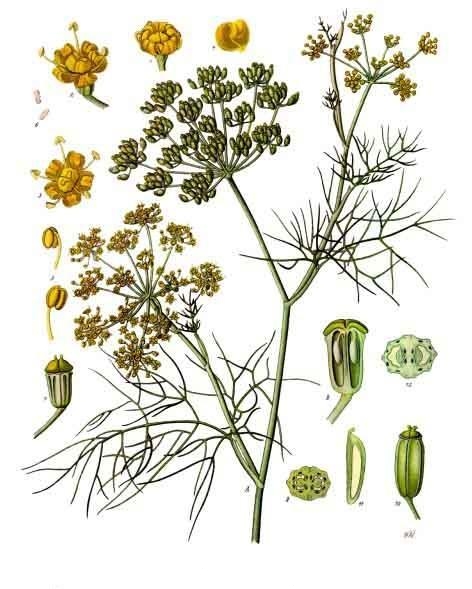
A Bit of History
Culinary Uses
Sugar-coated and un-coated fennel seeds are used in India and Pakistan in mukhwas, an after-meal snack and breath freshener.
The bulb, foliage, and seeds of the fennel plant are widely used in many of the culinary traditions of the world. The small flowers of wild fennel (mistakenly known in America as fennel "pollen" ) are the most potent form of fennel, but also the most expensive. Dried fennel seed is an aromatic, anise-flavoured spice, brown or green in colour when fresh, slowly turning a dull grey as the seed ages. For cooking, green seeds are optimal. The leaves are delicately flavoured and similar in shape to those of dill. The bulb is a crisp vegetable that can be sautéed, stewed, braised, grilled, or eaten raw. They are used for garnishes and to add flavor to salads. They are also added to sauces and served with pudding. The leaves used in soups and fish sauce and sometimes eaten raw as salad.
Fennel seeds are sometimes confused with those of anise, which are similar in taste and appearance, though smaller. Fennel is also used as a flavouring in some natural toothpastes. The seeds are used in cookery and sweet desserts.
Medicinal Uses
Fennel (Foeniculum vulgare) essential oil in clear glass vial
Fennel contains anethole, which can explain some of its medical effects: It, or its polymers, act as phytoestrogens.
The essence of fennel can be used as a safe and effective herbal drug for primary dysmenorrhea, but could have lower potency than mefenamic acid at the current study level.
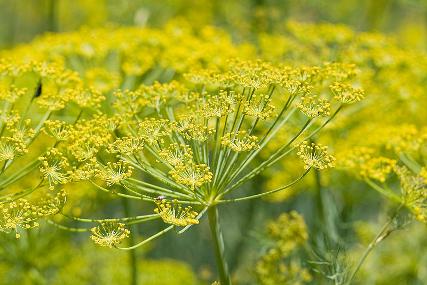
Intestinal Tract
Fennel is widely employed as a carminative, both in humans and in veterinary medicine (e.g., dogs), to treat flatulence by encouraging the expulsion of intestinal gas. Anethole is responsible for the carminative action.
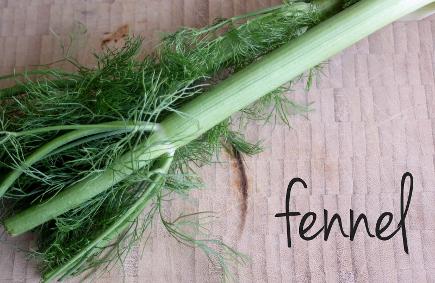
Mrs. Grieve's Herbal (1931) states :
On account of its aromatic and carminative properties, fennel fruit is chiefly used medicinally with purgatives to allay their tendency to griping and for this purpose forms one of the ingredients of the well-known compound Liquorice Powder. Fennel water has properties similar to those of anise and dill water: mixed with sodium bicarbonate and syrup, these waters constitute the domestic 'gripe water', used to correct the flatulence of infants. Volatile oil of Fennel has these properties in concentration. Fennel tea, formerly also employed as a carminative, is made by pouring half a pint of boiling water on a teaspoonful of bruised fennel seeds.
Fennel can be made into a syrup to treat babies with colic (formerly thought to be due to digestive upset), but long-term ingestion of fennel preparations by babies is a known cause of thelarche.
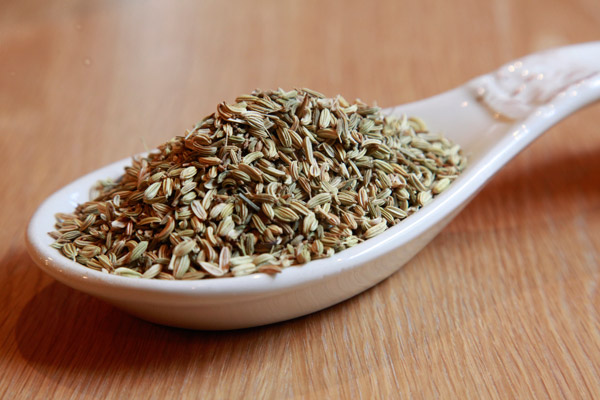
Eyes
In the Indian subcontinent, fennel seeds are also eaten raw, sometimes with some sweetener, as they are said to improve eyesight. Ancient Romans regarded fennel as the herb of sight. Root extracts were often used in tonics to clear cloudy eyes. Extracts of fennel seed have been shown in animal studies to have a potential use in the treatment of glaucoma.
Blood and Urine
Fennel may be an effective diuretic and a potential drug for treatment of hypertension. Do your research for more medicinal and culinary uses.
Janet P. Caldwell
Sources :
Healthy Eating
Fun with Food
by Janet P. Caldwell
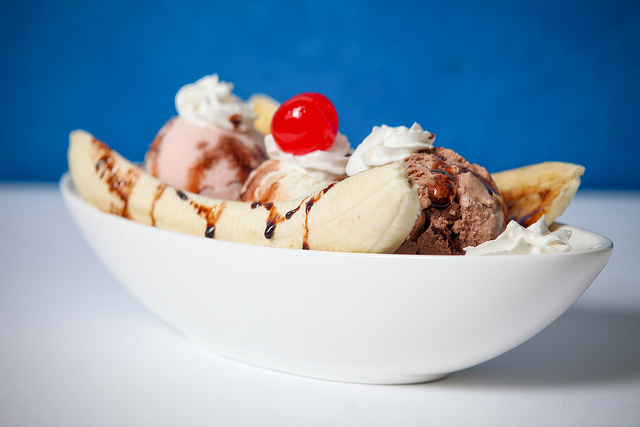
7 Expert Tips for Making Vegan Ice Cream
Recipe: Courtesy of Veg News Magazine
Vegan ice cream aficionado Hannah Kaminsky shares her tried-and-true tips for the ultimate summer cool-down treat.
Sizzling summer temperatures just beg for an ice cream scoop or two to cool down an otherwise blistering day. Yes, you could buy your own vegan pints, but what about when you’re craving something beyond cookies ‘n’ cream in Ben & Jerry’s territory? Perhaps you’re craving a s’mores ice cream, filled with vegan marshmallows, graham crackers, and chocolate chips swirled into a toasted marshmallow almond-milk ice cream. For essential tips on creating your own frozen indulgences, we turn to Hannah Kaminsky, the wunderkind behind the cookbook, Vegan à la Mode. She concocts flavors that you'll wish you’d dreamed up first (Thai Iced Tea Ice Cream, we’re looking at you). Kaminsky shares her best tricks for making quality homemade creations and even how to make your dessert sans ice cream maker.
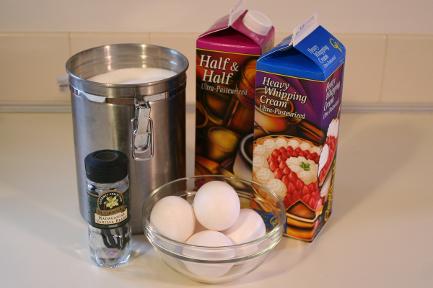
Use the right non-dairy milk as your base.
Kaminsky says that you’ll get the best results from dairy-free counterparts
that are higher in fat such as canned coconut milk. She typically uses almond
milk as her base, but other non-dairy milks can work (steer clear of rice milk
because it tends to be too watery).
You can make ice cream without an ice cream maker.
Not ready to splurge on a gadget to do the churning for you? Kaminsky shares,
“Pour the base out into a rectangle baking dish and place the dish on a level
surface in your freezer. Wait 45 minutes or so, and then using a fork scrape up
the ice crystals forming around the edges. Put the dish back into the freezer,
wait 30 minutes, and scrape again. Repeat until the entire mixture is frozen.”
While this technique will result in a less smooth texture than what you may be
used to, a great non-dairy base will still give you a dreamy rich taste.
If you want to invest in an ice cream maker, try these options.
Though Kaminsky used a pricier model to test out more than 100 recipes for her
cookbook, she highly recommends the Cuisinart ICE-21, which she used for years
until dropping it one too many times. If you own a KitchenAid Mixer, you can
buy an ice cream maker attachment. More affordable options include Hamilton
Beach and Nostalgic Electric, which offer $40-and-under models, or the Play and
Freeze Ice Cream Maker that literally turns ice cream making into a game; you
roll it around and 10 minutes later, your ice cream is ready. Plus, after all
that hard work, you deserve a scoop.
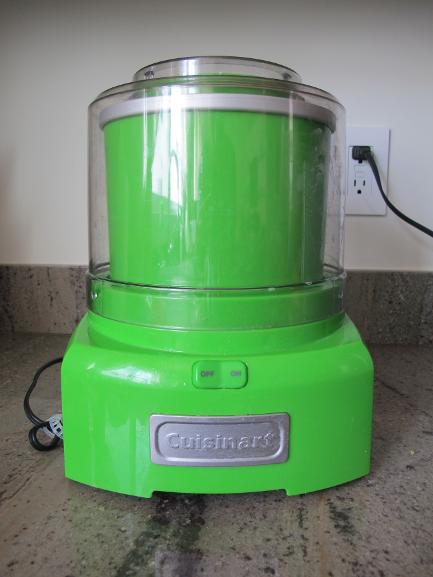
4. Carefully add in your mix-ins.
Now this is when you can get crazy and be the master of innovative ice cream.
Instead of tossing vegan chocolate chips into your mixer (which will result in
all the chips settling at the bottom of your cherry vanilla chip), Kaminsky
suggests adding your goodies in layers. “I like to put down a scoop or two of
ice cream, a handful of mix-ins, another two scoops of ice cream, and then more
mix-ins until everything is in the container. With a wide spatula, gently fold
the mixture, stirring from the bottom to top. This helps distribute things
pretty evenly. There will always be pockets with more goodies than others, but
finding them is half of the fun!”
continued . . . .
continued . . .
5. Get boozy.
Adding a little hooch can give ice cream the perfect flavor boost. In
Kaminsky’s Horchata Ice Cream recipe, she adds a touch of dark rum to play up
the rich vanilla and almond flavors in the base. Her other flavor suggestions
are happy hour-ready such as pairing Kahlua with chocolate flavors, citrusy
liqueurs Limoncello or Grand Marnier with fruit-based ice cream, and bourbon
with anything vanilla. A word of warning: don’t get too boozy because the more
you add, the softer your ice cream will turn out. If you want your pint
alcohol-free, Kaminksy recommends substituting a similar flavor extract and
adding non-dairy milk to replace the amount of alcohol called for in the
recipe.
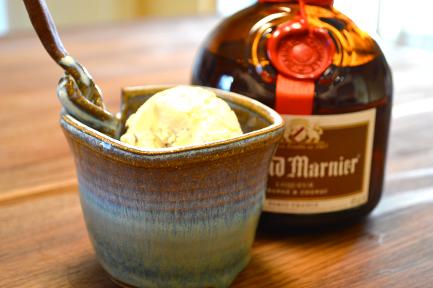
6. Get inspiration from other ice cream recipes.
You’ve found the perfect ice cream recipe online, but it’s not vegan. Instead
of trying to replace the eggs, take the flavor profiles and play with them.
Kaminsky says, “Any flavor can be created anew as a vegan recipe, so take
inspiration from other recipes. When all else fails, add your own twist to a
solid vanilla base.”

7. Give yourself time.
Kaminsky shares her secret to the perfect sweet treat: “The best frozen
desserts can’t be rushed.” Making your own amazing vegan ice creams take a
little elbow grease. First, you’ll need to freeze the ice cream maker bowl
overnight. Next, you cook the base and let it cool completely before chilling
in the refrigerator for several hours. Then, you’re ready to churn your desired
flavor in an ice cream maker (or by hand) and freeze your treat at least three
to four hours before downing the delicious quart you’ve just made.
Now that you’ve gotten the basics, it’s time to turn your kitchen into your very own ice cream shop and churn out your own flavors and toppings.
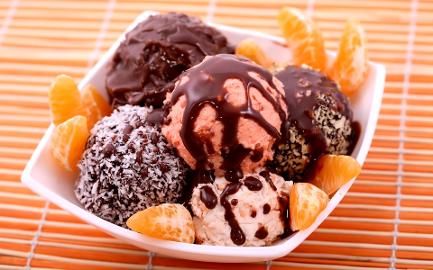
Ice Cream
Banana Ice Cream
Coffee Chip Frozen Yogurt
Hot Chocolate Ice Cream
Oatmeal Raisin Ice Cream Sandwiches
Peanut Butter Frozen Yogurt
Pumpkin Spice Frozen Yogurt
Strawberry Ice Cream
Vanilla Ice Cream
Toppings
Chocolate Ganache Glaze
Coconut Whipped Cream
Mexican Hot Chocolate Syrup
Pineapple Sauce
Rum-Caramel Sauce
Source: Recipe courtesy VegNews Magazine
Photo: Garrison McArthur Photographers
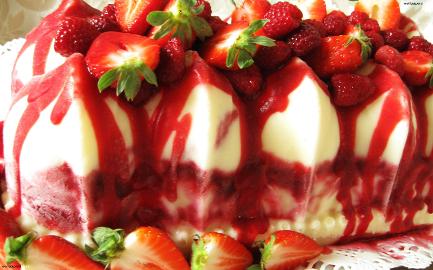
Introducing
Josh Wengler

Josh says that he is a “recovering journalist and staff reporter” and has been featured and worked world wide in magazine, newspapers and more. Josh is now a freelance writer, writing grants and assisting others with P.R. He says “I love food and the only thing I love more than eating great meals is sharing them with others, whether at the table or on the page.” So, please enjoy!

The Philosophy of Food

A very wise Székely man once said “Nem azért hogy együnk, azért eszünk hogy éljünk.”
Though Hungarian is often impossible to translate into English, a rough translation of this phrase might be ‘We don’t live for the joy of eating, we eat for the joy of living.”
It may be a debatable point, but one thing is for sure: After air and water, food is the one other thing we all share.
continued . . . .

Who among us does not have a special place in their heart — or stomach — for mom’s meatloaf, or grandma’s apple pie?
Maybe considering the ethnic lineage of the region, for you it’s not mom’s meatloaf, but her halushki, or sauerbraten, or corned beef and cabbage. Who knows? It could even be Uncle Gerry’s osso bucco.
The point is food is that one thing we all share. It is the universal language.
Having lived in other countries, I can tell you from experience that even when you can’t speak a word of the local language, appreciating the cuisine of your hosts speaks volumes.
It doesn’t have to be a four-star canard l’orange prepared in the classical French style either, where it looks more like a gaudy painting framed in aspic than a duck. In fact, one of the best meals I’ve ever had was a shapeless conglomeration of eggs, potatoes and sausage served straight out of the cake pan it was baked in.
What made that meal so great was that it came directly from the same hands that planted, tended and harvested the potatoes, plucked the still-warm eggs from under the chicken and performed the hundreds of activities involved in getting the pig from pen to plate.
Somewhere along the line we seem to have forgotten the meaning of the food we eat in this country. We’ve abandoned the aspects of food that truly sustain us. It’s not the caloric content or the protein/carbohydrate ratio of the meal that nourishes us so much as it is the amount of care that was put into it before it got to the table.
I’m not saying everybody should have to raise their own crops and livestock for the food to be truly sustaining, (though anyone that has been fortunate enough to partake of such delicacies knows how much better food tastes that way) but I would argue that there is a direct correlation between the thoughtfulness put into preparing and presentation of a meal and the amount of sustenance one takes from it.
If I go into a supposedly top-notch restaurant and amid the soft lighting and appealing decor I am served a plate of stuff I could have made twice as good at home by a disinterested waiter and a robot of a “chef” simply assembling ingredients as though he were on an assembly line, I will grudgingly pay my overinflated bill and go home grumbling about man’s insensitivity to man.
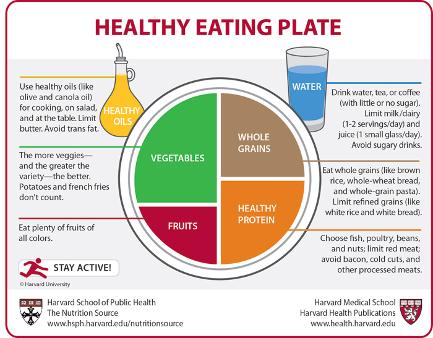
If, on the other hand, I go into a roadside honky - tonk with sawdust on the floor and am blown away by the ribs roasted to saucy perfection by a greasy-looking guy who obviously cares as deeply about the food he prepares as he is about the bottle of whiskey he’s nursing, I will tip the most miserable waitress double what she deserves and waddle home full of hope for mankind.
Food is an art. In fact, I would argue food is the ultimate art, more important than painting, than writing, than sculpture or philosophy. Without it, painters could not paint, writers could not write, nor sculptors sculpt or thinkers think.
Whether it is your own mom or a great culinary master, the chef who truly cares about his or her art is a greater artist than any of these, because his or her creations are offered up to be immediately consumed. Though the perfectly presented masterpiece is gone in mere moments, the sensations it produced, the memories of the moment shared with friends and loved ones and the psychic, physical and emotional nourishment derived thereof live on within you. Food, in short, is life.
You are what you eat.
Josh Wengler


Janet P. Caldwell is a Prolific and sometimes Eclectic Writer and Poet. Though she has only published 3 Books thus far, 5 Degrees to Separation (2003); Passages (2012); Dancing toward the Light (2013), there is no doubt that she has been holding out on the world with her beautiful Healing Vision and keen insight. We do expect her to step up the game.
For the past 2 years Janet has been working very closely with William S. Peters, Sr. of Inner Child and has graciously taken on the role of service. She is fulfilling the role of Chief Administrator which encompasses Managing Editor of Inner Child Magazine; Program Director of Inner Child Radio and Administrator of Production for Inner Child Press. She wears many hats.
When this role to serve the Magazine’s World Wide Readership became available Janet quickly volunteered without hesitation. She is a cherished soul by all that know her and have had the opportunity to converse with her and call her friend.
To read more about
Janet and her work go to . . .

Firing Up the Grill

With Spring upon us and summer approaching, many of us will be firing the grill up. I can hardly wait! The great thing about grilling is that you can grill anything! I love grilled veggies but wanted to offer a recipe that I found on the web-site Eating Well, that sounded tasty and I intend to try it.

This grilled pork dish offers a triple hit of the fruit with an apricot preserve glaze for the tenderloin plus a grilled apricot and watercress salad with an apricot-spiked vinaigrette. Serve with a chilled Chardonnay, which will harmonize beautifully with the smoky-sweetness of grilled apricots.
Bon Apetite,
Janet P. Caldwell

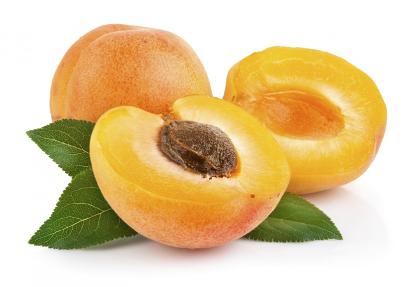
Grilled
Pork Tenderloin
&
Apricot Salad
4 servings
Active Time: 40 minutes
Total Time: 40 minutes
Ingredients
1 pound pork tenderloin,trimmed
1/2 teaspoon salt, divided
1/4 teaspoon freshly ground pepper, plus more to taste
3 tablespoons apricot preserves, divided
4 ripe but firm fresh apricots or nectarines, halved and pitted
2 tablespoons white-wine vinegar
2 tablespoons minced shallot
2 tablespoons canola oil
1 4- 5 ounce bag watercress, or baby arugula (about 8 cups)

Preheat grill to high.
Sprinkle pork with 1/4 teaspoon salt and pepper. Oil the grill rack (see Tip). Grill the pork, turning occasionally, for 10 minutes. Brush the pork with 2 tablespoons preserves and continue grilling until an instant-read thermometer inserted into the thickest part registers 145°F, 2 to 5 minutes more. Grill apricot (or nectarine) halves on the coolest part of the grill, turning occasionally, until tender and marked, about 4 minutes. Transfer the pork and apricots to a clean cutting board and let rest for 5 minutes.
Meanwhile, whisk the remaining 1 tablespoon preserves, vinegar, shallot, oil, 1/4 teaspoon salt and pepper to taste in a large bowl. Cut the fruit into wedges and add to the dressing along with watercress (or arugula); toss to coat. Thinly slice the pork. Serve the salad with the sliced pork.

Tips & Notes
Tip: To oil the grill rack: Oil a folded paper towel, hold it with tongs and rub it over the rack. (Don't use cooking spray on a hot grill.)
Nutrition
Per serving: 247 calories; 10 g fat ( 1 g sat , 5 g mono ); 74 mg cholesterol; 15 g carbohydrates; 25 g protein; 1 g fiber; 363 mg sodium; 653 mg potassium.
Nutrition Bonus: Selenium (47% daily value), Vitamin A (40% dv), Vitamin C (30% dv), Potassium (18% dv)
Carbohydrate Servings: 1
Exchanges: 1 fruit, 3 lean meat, 1 1/2 fat
Source: Eating Well
Pics: Public Domain
11 Blue Lantern.mp3
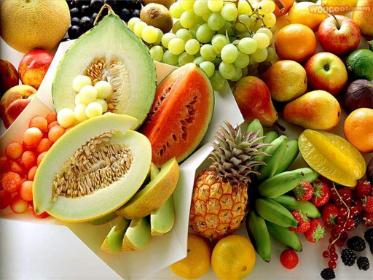

For more information on becoming a Sponsor or Advertising with us at Inner Child Magazine
click HERE
